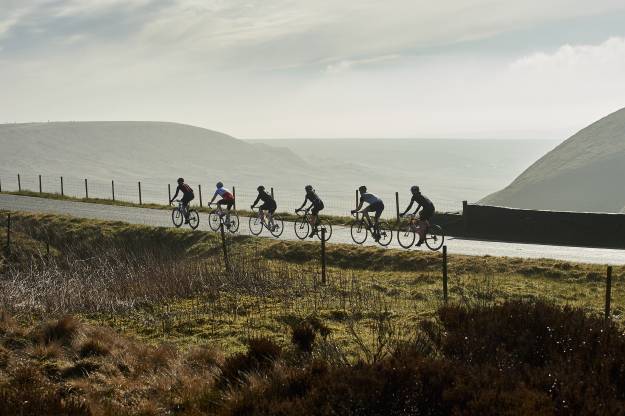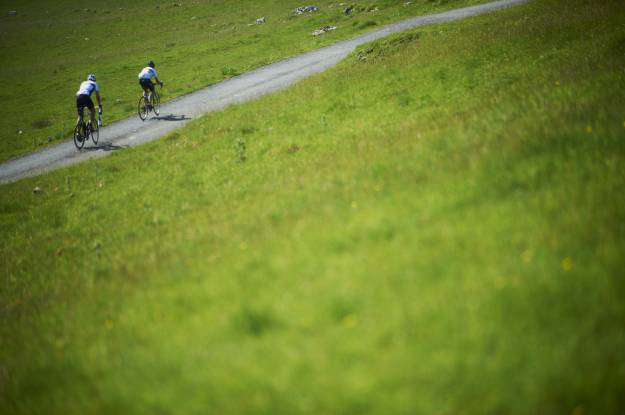
Know your Enemy:
According to MET Office statistics, in rains one day in three in England, so it's wise to have a strategy to cope with the inevitable deluge. 'Winging it' in the face of the UK climate just isn't going to work. However doom laden the above stat sounds, it's sweetened by the fact that you probably won't be out while it's raining. More likely is that you'll be riding on wet roads, freshly soaked by a recent shower. Get a set of full length guards and a front mudflap and you're sorted. However, if you do get caught when it's actually raining, there are a few different ways to react.
Less is more?
The simplest and cheapest approach to riding in the rain is to just accept that you're going to get wet and make sure that you've got dry clothes to change into at the end of your ride. Provided you keep warm enough, this can be a fine approach in all but the heaviest rain and the longest rides. Most seasoned riders will tell you that no matter what you wear, if you ride long enough in the rain, you're going to get wet. Don't try this in the depths of winter though - hypothermia is no laughing matter.
'I wanna be a lighthouse keeper..."
Other riders favour a full coverage approach, with full-on waterproof jacket and overtrousers. This approach is often favoured by riders who are not in a hurry and want to keep the clothes beneath clean and dry. In theory this sounds like a great idea. In practice it usually results in a sweaty, uncomfortable, overheated and irritable cyclist, even if you really take it easy. You'll also look like a lighthouse keeper if you're not careful.
The Middle Way
As in many areas of life, steering the middle ground can often be the best when dealing with rain. Starting with your bottom half, begin by wearing materials that dry quickly if they do get wet. Lightweight polyester travel-type pants, even if they get saturated, will dry in 30 minutes. In cooler weather, waterproof Goretex lined travel shoes will keep your feet dry. In warmer weather, sandals work great as there's less material to get wet and therefore less material to dry out. The same applies to trousers. Lightweight three-quarter style trousers dry out in no time and can't get wet around the ankles, usually the place where your legs get the wettest, even with mudguards.
Working your way up to the torso, wool is great for jerseys as it stays warm even when damp, wicks moisture away from the skin and doesn't stink like polyester. If you don't like the feel or tree-huggin stigma of wool, you can get some polyster tops which have been treated with anti baterial coatings to stop the niff (anyone who's left a used synthetic cycling top in a locker for a week will know what I'm talking about.)
Buy the most breathable waterproof you can afford and use it sparingly, Don't bother wearing it in very light rain - in all but the coldest weather you'll overheat. Remove it as soon as the rain starts to ease. It's all too easy to keep a waterproof on after the worst of the rain has subsided, only to arrive at your destination wetter on the outside than on the inside.
Think about the riding you do. If you're regularly out all day or your commute is long, a full waterproof is the way to go. If your ride is short, you might get away with a showerproof jacket (Pertex or similar) that'll keep off the worst of the rain but keep you relatively cool.
Mudguards
I briefly mentioned mudguards before. Full length is best and keeps you and your bike much cleaner than anything else. But not everyone likes the full mudguard look. So there are MTB style guards such as the Crud Catcher and derivatives, which keep the worst of the spray off your backside and out of your teeth.
If you're going for the full mudguard approach, add a mudflap to the front guard. You can buy them or make one out of a piece of rubber or leather, plus a few small nuts and bolts to hold it onto the guard. This will keep your feet almost totally dry if your make it long enough. It'll also stop dirty, salty water from being sprayed at your chainset and bottom bracket, which, if they could speak, would no doubt thank you for it.
Try these tips next time the weather turns sour and remember, in this case, every cloud does have a silver lining. Cos when it's raining, there are usually less cars on the road.









